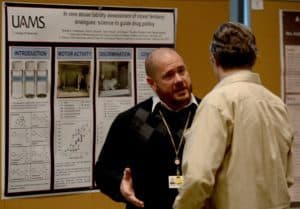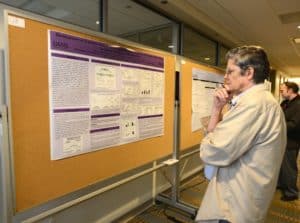Nov. 27, 2018 | A variety of solutions with which to attack the ongoing national opioid epidemic took center stage at the 22nd Showcase of Medical Discoveries, held Nov. 14 in the UAMS Winthrop P. Rockefeller Cancer Institute.
The series is intended to foster scientific collaboration by sharing research through social receptions with poster presentations. It is sponsored by the College of Medicine and Division of Research.
“One thing I learned in my time of being an investigator is you need a variety of approaches to solve a problem,” said Lawrence Cornett, Ph.D., UAMS associate vice chancellor for research. “That’s why team science is so valuable and why collaborations are so valuable. You want to have diverse viewpoints thinking about the problem and how to solve it. If you only take a single path to the solution, a lot of times you’re going to fail.”
The research on display included exploring viable medications to use as an alternative to opioids, to treatment of addiction as well as withdrawal, to studying emerging illicit opioids to understand their effects on abusers. That work included not only presentations from UAMS researchers, but researchers from the Central Arkansas Veterans Healthcare System, which adjoins the UAMS campus.
“I think you need to take every possible approach to this problem,” said Rick Owen, M.D., associate chief of staff for research with Veterans Affairs (VA) and a professor of psychiatry in the UAMS College of Medicine. “My background is in implementation science and health services research, so the fact that there are a few posters on actually implementing change and how to approach that is very impressive.”
Among those was the work of student researcher Mary Thannisch, who presented work done in collaboration with Benjamin Teeter, Ph.D., of the UAMS College of Pharmacy, on finding ways to increase prescription of overdose prevention medication naloxone among pharmacists.
“Last year, Arkansas passed a law allowing pharmacists to prescribe naloxone to the public instead of going to a physician. But since that’s happened, the prescription rate has not been very high. There’s a certain stigma attached to naloxone, because most people think it’s only for addicts,” Thannisch said. “However, in addition to addicts, our research also targets the accidental overdoses that might happen, such as in older patients on multiple medications” or in households with very young children.
Thannisch said the work included studying ways for pharmacists, who in many cases – particularly in independently owned pharmacies – know their patients personally, to start a conversation about prescribing naloxone with opioids as a preventative measure. However, their surveys showed many pharmacists don’t quite feel they have the right training to begin those conversations.
“So what we came up with were conversation guides, a laminated sheet of paper they can keep in the pharmacy for each target patient they would be looking at.”

Ravi Nahata, M.D., a UAMS assistant professor and staff psychiatrist with the VA, presented work that gauged the acceptability and interest of opioid-addicted patients to using naltrexone, a medication often used to treat heroin addicts. Nahata said he and fellow researchers hypothesized opioid users would be hesitant to explore the medication for fear of stigma, but found exactly the opposite reaction in surveys.
“Our hypothesis was that people exposed to methadone or Suboxone would be less interested in naltrexone, but our finding was actually the opposite. People with exposure were likely to consider it,” he said.
The survey also collected data from those who were not interested in naltrexone. Their reasons included fear of needles, potential side effects, prohibitive cost and simply not being ready to end opioid use.
While there is still much work to do in combating the multifaceted problem of opioid use throughout the United States, events such as the showcase not only help further research by fostering collaboration, they demonstrate the vital role academic research centers like UAMS play in finding solutions.
“I think the public recognizes that academic research centers are where research is done to improve human health, so I think they expect us to take the lead. If not us, then who else is going to do it?” said Cornett.
“This is the kind of problem that really hits home when you know people who have been affected by it,” said Owen. “You know people who have become addicted or have been in treatment or you know of families that have had a family member overdose. People can identify with that.”
Poster presentations at the showcase included:
Management of Infants Exposed in utero to Opioids
Researchers: Jeanette Lee and Jessica Snowden
The Effects of P-glycoprotein Inhibition on Norbuprenorphine-induced Neonatal Abstinence Syndrome (NAS)
Researchers: Paloma Salazar, Williams T. Higgins, Lisa Brents
Morphine 6-O-Sulfate is a Novel Mixed µ/δ Opioid Therapeutic for Diabetic Neuropathy: Pharmacology, Pharmacokinetics, and Blood Brain Barrier Permeability
Researchers: Jai Shankar K. Yadlapalli, Zaineb Albayati, Benjamin M. Ford, Amit Ketkar, Anqi Wan, Narasimha Penthala, Robert Eoff, Paul L. Prather, Howard Hendrickson, Maxim Dobretsov and Peter A. Crooks
Improving Opioid Use Disorder Treatment Outcomes with the L-type Calcium Channel Blocker Isradipine
Researchers: A.H. Oliveto, J. McGaugh, J.B. Guise, J. Thostenson and M.J. Mancino
A Survey of Treatment Preferences for Opioid Use Disorder
Researchers: R. Nahata, M.J. Mancino, J. Thostenson, A. Oliveto
Community Pharmacists’ Perceptions of Their Role in the Opioid Epidemic
Researchers: Benjamin Teeter, Geoffrey Curran, Bradley Martin, Patricia Freeman, Karen Drummond, Katharine Bradley, Mark Edlund
In vivo Abuse Liability Assessment of Novel Fentanyl Analogues: Science to Guide Drug Policy
Researchers: William E. Fantegrossi, Kyle R. Urquhart, Saki Fukuda, Jyoti Gogoi, Timothy Flanigan and Takato Hiranita
A Comparison of the Antinociceptive Effects of ZZ204G, an α9α10 nAChRs Antagonist and Morphine in a Rodent Model
Researchers: Anqu Wani, Jai Shankar K. Yadlapalli, E. Kim Fifer, Maxim Dobretsov, Zaineb Albayati and Peter A, Crooks
In vivo Dependence Liability Assessment of Novel Fentanyl Analogues: Science to Guide Drug Policy
Researchers: Kyle R. Urquhart, Saki Fukuda, Jyoti Gogoi, Timothy Flanigan, Takato Hiranita and William E. Fantegrossi
Development of G-protein Biased Cannabinoid Receptor Agonists as Potential Alternatives to Opioid Treatment of Chronic Pain
Researchers: Paul L. Prather, Narsimha R. Renthala, William E. Fantegrossi and Peter A. Crooks
Evidence Based Quality Improvement (EBQI) for Development and Implementation of Community Pharmacist-Initiated Prescribing and Dispensing of Naloxone
Researchers: Mary Thannisch, Benjamin Teeter, Geoffrey Curran, Duane Jones, Bradley Martin, Nickolas Zaller



